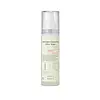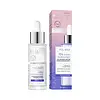What's inside
What's inside
 Key Ingredients
Key Ingredients

 Benefits
Benefits

 Concerns
Concerns

 Ingredients Side-by-side
Ingredients Side-by-side

Water
Skin ConditioningButylene Glycol
HumectantNiacinamide
SmoothingEthylhexyl Stearate
EmollientCaprylic/Capric Triglyceride
MaskingCetyl Ethylhexanoate
EmollientGlutathione
Sodium Ascorbyl Phosphate
AntioxidantSalix Alba Bark Extract
AstringentAdenosine
Skin ConditioningSodium Hyaluronate
HumectantHydroxypropyltrimonium Hyaluronate
Sodium Acetylated Hyaluronate
HumectantHydrolyzed Hyaluronic Acid
HumectantHyaluronic Acid
HumectantSodium Hyaluronate Crosspolymer
HumectantHydrolyzed Sodium Hyaluronate
Skin ConditioningPotassium Hyaluronate
Skin ConditioningPanthenol
Skin ConditioningSqualane
EmollientGlycerin
HumectantAllantoin
Skin ConditioningCyanocobalamin
Skin ConditioningTerminalia Ferdinandiana Fruit Extract
AntioxidantHippophae Rhamnoides Fruit Extract
Skin ConditioningMalpighia Glabra Fruit Extract
Skin ConditioningBrassica Oleracea Italica Extract
AstringentMorus Alba Root Extract
BleachingPhaseolus Radiatus Seed Extract
Skin ConditioningCanavalia Gladiata Seed Extract
Skin ConditioningGlycine Soja Seed Extract
Skin ConditioningLens Esculenta Seed Extract
Skin ProtectingCeratonia Siliqua Seed Extract
Skin ConditioningCentella Asiatica Leaf Extract
Skin ConditioningCeramide NP
Skin ConditioningAcetyl Octapeptide-3
HumectantDipeptide-1
Skin ConditioningTripeptide-2
Skin ConditioningPalmitoyl Dipeptide-7
Skin ConditioningDipeptide-4
Skin ConditioningSorbitan Stearate
EmulsifyingCetearyl Alcohol
Emollient1,2-Hexanediol
Skin ConditioningStearic Acid
CleansingPolysorbate 60
EmulsifyingEthylhexylglycerin
Skin ConditioningHydrogenated Olive Oil Unsaponifiables
EmollientDisodium EDTA
Hydroxypropyl Cyclodextrin
MaskingPueraria Lobata Root Extract
HumectantLactobacillus Ferment Lysate
Skin ConditioningChlorphenesin
AntimicrobialMaltodextrin
AbsorbentMelia Azadirachta Flower Extract
Skin ConditioningOcimum Sanctum Leaf Extract
Skin ConditioningMelia Azadirachta Leaf Extract
Skin ConditioningArginine
MaskingPhytosterols
Skin ConditioningCarbomer
Emulsion StabilisingCurcuma Longa Root Extract
MaskingCorallina Officinalis Extract
Skin ConditioningCaprylyl Glycol
EmollientSodium Citrate
BufferingPolyglyceryl-10 Laurate
Skin ConditioningCitric Acid
BufferingWater, Butylene Glycol, Niacinamide, Ethylhexyl Stearate, Caprylic/Capric Triglyceride, Cetyl Ethylhexanoate, Glutathione, Sodium Ascorbyl Phosphate, Salix Alba Bark Extract, Adenosine, Sodium Hyaluronate, Hydroxypropyltrimonium Hyaluronate, Sodium Acetylated Hyaluronate, Hydrolyzed Hyaluronic Acid, Hyaluronic Acid, Sodium Hyaluronate Crosspolymer, Hydrolyzed Sodium Hyaluronate, Potassium Hyaluronate, Panthenol, Squalane, Glycerin, Allantoin, Cyanocobalamin, Terminalia Ferdinandiana Fruit Extract, Hippophae Rhamnoides Fruit Extract, Malpighia Glabra Fruit Extract, Brassica Oleracea Italica Extract, Morus Alba Root Extract, Phaseolus Radiatus Seed Extract, Canavalia Gladiata Seed Extract, Glycine Soja Seed Extract, Lens Esculenta Seed Extract, Ceratonia Siliqua Seed Extract, Centella Asiatica Leaf Extract, Ceramide NP, Acetyl Octapeptide-3, Dipeptide-1, Tripeptide-2, Palmitoyl Dipeptide-7, Dipeptide-4, Sorbitan Stearate, Cetearyl Alcohol, 1,2-Hexanediol, Stearic Acid, Polysorbate 60, Ethylhexylglycerin, Hydrogenated Olive Oil Unsaponifiables, Disodium EDTA, Hydroxypropyl Cyclodextrin, Pueraria Lobata Root Extract, Lactobacillus Ferment Lysate, Chlorphenesin, Maltodextrin, Melia Azadirachta Flower Extract, Ocimum Sanctum Leaf Extract, Melia Azadirachta Leaf Extract, Arginine, Phytosterols, Carbomer, Curcuma Longa Root Extract, Corallina Officinalis Extract, Caprylyl Glycol, Sodium Citrate, Polyglyceryl-10 Laurate, Citric Acid
Water
Skin ConditioningGlycolic Acid
BufferingSodium Hydroxide
BufferingAloe Barbadensis Leaf Juice
Skin ConditioningPentylene Glycol
Skin Conditioning1,2-Hexanediol
Skin ConditioningMandelic Acid
AntimicrobialGluconolactone
Skin ConditioningHyaluronic Acid
HumectantSalicylic Acid
MaskingLactic Acid
BufferingCitric Acid
BufferingMalic Acid
BufferingHydrolyzed Glycosaminoglycans
HumectantCalcium Gluconate
HumectantHydroxyethylcellulose
Emulsion StabilisingGlycerin
HumectantHydroxyacetophenone
AntioxidantSodium Benzoate
MaskingDisodium Phosphate
BufferingPolysorbate 60
EmulsifyingSodium Phosphate
BufferingWater, Glycolic Acid, Sodium Hydroxide, Aloe Barbadensis Leaf Juice, Pentylene Glycol, 1,2-Hexanediol, Mandelic Acid, Gluconolactone, Hyaluronic Acid, Salicylic Acid, Lactic Acid, Citric Acid, Malic Acid, Hydrolyzed Glycosaminoglycans, Calcium Gluconate, Hydroxyethylcellulose, Glycerin, Hydroxyacetophenone, Sodium Benzoate, Disodium Phosphate, Polysorbate 60, Sodium Phosphate
Ingredients Explained
These ingredients are found in both products.
Ingredients higher up in an ingredient list are typically present in a larger amount.
1,2-Hexanediol is a synthetic liquid and another multi-functional powerhouse.
It is a:
- Humectant, drawing moisture into the skin
- Emollient, helping to soften skin
- Solvent, dispersing and stabilizing formulas
- Preservative booster, enhancing the antimicrobial activity of other preservatives
Citric Acid is an alpha hydroxy acid (AHA) naturally found in citrus fruits like oranges, lemons, and limes.
Like other AHAs, citric acid can exfoliate skin by breaking down the bonds that hold dead skin cells together. This helps reveal smoother and brighter skin underneath.
However, this exfoliating effect only happens at high concentrations (20%) which can be hard to find in cosmetic products.
Due to this, citric acid is usually included in small amounts as a pH adjuster. This helps keep products slightly more acidic and compatible with skin's natural pH.
In skincare formulas, citric acid can:
While it can provide some skin benefits, research shows lactic acid and glycolic acid are generally more effective and less irritating exfoliants.
Most citric acid used in skincare today is made by fermenting sugars (usually from molasses). This synthetic version is identical to the natural citrus form but easier to stabilize and use in formulations.
Read more about some other popular AHA's here:
Learn more about Citric AcidGlycerin is already naturally found in your skin. It helps moisturize and protect your skin.
A study from 2016 found glycerin to be more effective as a humectant than AHAs and hyaluronic acid.
As a humectant, it helps the skin stay hydrated by pulling moisture to your skin. The low molecular weight of glycerin allows it to pull moisture into the deeper layers of your skin.
Hydrated skin improves your skin barrier; Your skin barrier helps protect against irritants and bacteria.
Glycerin has also been found to have antimicrobial and antiviral properties. Due to these properties, glycerin is often used in wound and burn treatments.
In cosmetics, glycerin is usually derived from plants such as soybean or palm. However, it can also be sourced from animals, such as tallow or animal fat.
This ingredient is organic, colorless, odorless, and non-toxic.
Glycerin is the name for this ingredient in American English. British English uses Glycerol/Glycerine.
Learn more about GlycerinHyaluronic acid is naturally found in healthy skin. It is a humectant, meaning it draws moisture to your skin.
This ingredient helps hydrate, soothe, and protect the skin.
What makes hyaluronic acid so hydrating? It has the capacity to bind or hold large amounts of water.
Fun fact: It is already naturally found in our bodies, such as the fluids of our eyes and our joints.
Studies find this ingredient to have anti-inflammatory and anti-microbial properties. This can help speed up wound-healing.
Hyaluronic acid can be irritating if the molecule has a low-molecular weight, or if the molecules are small.
One study found low-molecular weight hyaluronic acid to be pro-inflammatory, meaning some people may experience irritation. This is because our bodies use hyaluronic acid in the wound-healing process to signal to our bodies, via irritation, that something needs healing.
The same study found high-molecular weight hyaluronic acid to be anti-inflammatory.
These are some other common types of Hyaluronic Acid:
Learn more about Hyaluronic AcidPolysorbate 60 is used to help stabilize products. It is a surfactant and emulsifier. These properties help keep ingredients together in a product. Surfactants help reduce surface tension between ingredients with different states, such as liquids and solids. Emulsifiers help prevent oils and waters from separating.
Polysorbate 60 is sorbitol-based and created from the ethoxylation of sorbitan. Ethoxylation is a chemical reaction used to add ethylene oxide. Sorbitan is a the dehydrated version of sorbitol, a sugar found in fruits.
In this case, the 60 comes from reacting 60 units of ethylene oxide with sorbitan.
Polysorbates are commonly used in medicine and foods.
Learn more about Polysorbate 60Water. It's the most common cosmetic ingredient of all. You'll usually see it at the top of ingredient lists, meaning that it makes up the largest part of the product.
So why is it so popular? Water most often acts as a solvent - this means that it helps dissolve other ingredients into the formulation.
You'll also recognize water as that liquid we all need to stay alive. If you see this, drink a glass of water. Stay hydrated!
Learn more about Water